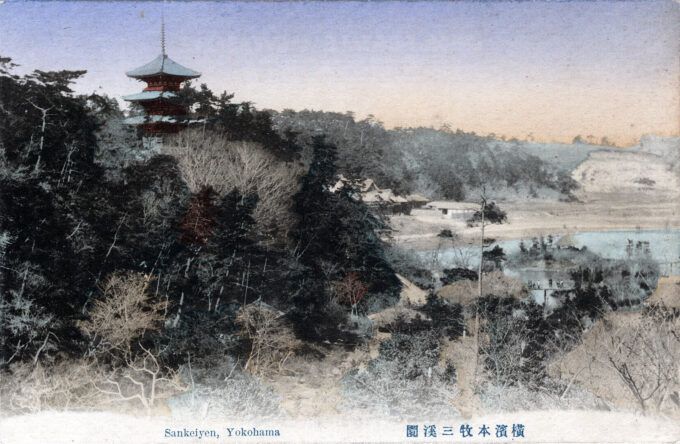
“Sankeiyen” [“Three Creeks Garden”], Yokohama, c. 1920. Frst opened to the public in 1906 by Tomitaro Hara, a Yokohama silk trader known by the pseudonym ‘Sankei Hara’, almost all of the garden’s buildings are historically significant bought by Hara himself and relocated there from locations all over Japan, including the Tomyo-ji (seen above), a three-story pagoda originally constructed in Kyoto in 1457 and relocated to Sankeiyen in 1914. Sankeiyen is also popular for its cherry and ume [plum] blossoms, and colorful autumn foliage.
See also:
Silk Conditioning House, Yokohama, c. 1935.
Silk production, c. 1920.
“Sankei-en Garden [is] owned by Mr. Tomitaro Hara, son of the pioneer of the silk trade in Yokohama, who has opened it to the public. The garden covers about 30 acres along the seashore, and can be reached by a ten minutes’ walk from the Honmoku car or bus-stop.
“It contains many historic buildings which have been brought from other parts of the country, including the house called Taisyun-ken (‘Spring-Waiting House’) which once stood at a village near Nikko, where General Grant took lunch when he visited a filature there in 1879. Close by is a thatched arbor where a log fire is burning in an old-fashioned open fireplace, above which a kettle is kept boiling to provide visitors with tea. Opposite the teahouse across a bridge is a small cottage calld ‘Yokobue-en’, in which is placed a stauette of Yokobue, a fiar Court attendant of the 12th century, who is said to have made the statuette herself out of the letters sent her by her lover.
“… The three-storied pagoda on the hill was brought from Tomyo-zi Temple at Kamo, Kyoto, and is said to be more than 1,000 years old. There are the Tenzui-in structures which contain the Rinsyunkaku Hall, said to have been a part of Hideyoshi’s Momoyama mansion and some other historic halls and pavilions.
“Many of these old structures are registered as ‘national treasures’.”
– Japan: The Official Guide, Japanese Government Railways, 1941
- Sankeiyen, Yokohama, c. 1920.
- Sankeiyen, Yokohama, c. 1920.
“I seldom dream of Yokohama now, but my memories of childhood and youth are snugly tucked away. As bedtime stories I occasionally tell my son and daughter about the times my brother or my neighborhood pals and I explored the tunnels (dug during the war as shelters), hills and woods near our home that led to a secret opening to Sankeien Gardens.
“That was our secret garden – with its three-storied pagoda, teahouses, ponds full of colorful carp and crayfish and tadpoles and water lilies, the rich hues of spring and fall, of cherry blossoms, azaleas and maples. It was secret because it was still closed to the public in those days after suffering extensive war damage [in 1945]. We were told by our elders that there lurked cunning badgers and foxes who could transform into humans and try to deceive us. ‘Look for their tails,’ they told us. ‘That’s how they always give themselves away.’
“Not long ago I went back to Yokohama–to Sankeien and to other sites of my childhood.
“Sankeien (‘garden of three glens’) on the southeast side of the city is now a meticulously groomed public park with several temples and buildings designated as national treasures. During my recent visit I walked the grounds with an old neighborhood pal who still lives near the park.
“This was once the private garden of a rich merchant, Tomitaro Hara, who made a fortune in the silk trade almost a century ago. Hara bought several temples and teahouses in Kyoto and had them disassembled and rebuilt here, perhaps in an attempt to create a garden reminiscent of those built by shoguns and emperors in the ancient capital of Kyoto. Though it pales when compared to the imperial gardens of Kyoto, Sankeien is nevertheless Yokohama’s finest.”
– “Sharing Memories of a Yokohama Childhood After Making the Journey Home Decades Later”, by Kunio Frances Tanabe, Los Angeles Times, Feb. 25, 1990




